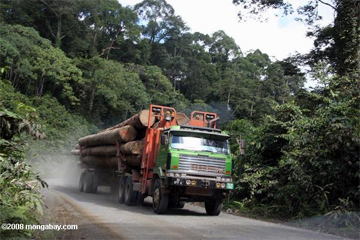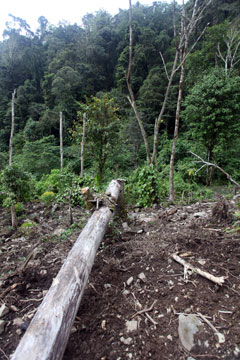Tropical forest degradation progresses in a series of “waves”, with forests initially exploited for high value products like hardwoods and then eventually used for successively lower value goods like firewood and fodder, reports new research published in the Proceedings of the National Academy of Sciences.
The study, which tested economic theory predicting “a systematic allocation of land to its highest use value in response to distance from centers of demand”, found that forest exploitation in Tanzania between 1991 and 2005 indeed expanded “through time and space as concentric waves, with each wave targeting lower value products.” Tanzanian forests close to Dar es Salaam, the capital and a major trading hub, were initially exploited for precious timber suitable for export markets. As valuable hardwoods were depleted, loggers moved into more distant areas. Meanwhile other actors began to extract progressively smaller, less valuable trees from logged-over forest areas, eventually moving down the value chain to scrap wood for charcoal production. The process diminished the ecological capacity of forests, including carbon storage, biodiversity, and provisioning of other ecosystem services, according to the authors, led by Antje Ahrends of the Royal Botanic Garden in Edinburgh and the University of York.
|
|
“The progressive decline in the value of harvested woody resources at a given distance from Dar es Salaam over the past decade and increasing distance of transport for equivalent-value products over time suggest a likely unsustainable ‘logging down the profit margin’ scenario akin to the sequential ‘fishing down the food web’ resource utilization patterns seen in unmanaged marine habitats,” they write. “At current levels of demand and continued outward expansion of the exploitation waves, we predict that there will be no high-value timber species remaining in Tanzanian coastal forests up to 220 km from Dar es Salaam in 2010 and up to the southern Tanzanian border within 37 years.”
The authors argue their work can be used to forecast forest degradation in other regions.
“Our study suggests that tropical forest degradation can be modeled and predicted,” they write.
|
|
Indeed, trends in other parts of the world would seem to confirm the study’s conclusions. Forest conversion in the Brazilian Amazon often begins with selectively logging that removes high value species like mahogany. Lower-value timber is subsequently harvested for fuelwood, charcoal production, and in some cases pulp. The remaining land may be burned and converted for low-intensity cattle ranching. In Southeast Asia, valuable hardwoods are cut first. The forest may later be logged for less valuable species and pulped, for eventual conversion to timber or oil palm plantations, a transition back up the value chain.
CITATION: Ahrends, A. et al. Predictable waves of sequential forest degradation and biodiversity loss spreading from an African city. PNAS Early Edition for the week of July 5, 2010.

